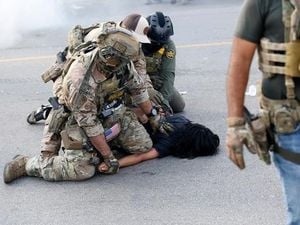On August 30, 2025, a 16-year-old cosplayer dressed as the enigmatic Resident Evil character HUNK was arrested outside Stamford Bridge stadium in London for carrying what police described as a “realistic-looking imitation firearm.” The incident, which unfolded on Fulham Broadway as crowds gathered for a Chelsea vs. Fulham soccer match, has reignited debate in the UK about the intersection of cosplay culture and strict firearm laws.
According to the Metropolitan Police, unarmed officers responded swiftly to reports of a boy carrying a weapon in a crowded area. The teenager, believed to be en route to the nearby London Anime & Gaming Convention, was stopped and taken into custody. Police later confirmed that the item in question was a replica MP5 submachine gun—an accessory closely associated with the HUNK character from the Resident Evil video game franchise. No injuries were reported, and the area was secured without further incident.
Early media reports mischaracterized the event as an attempted shooting, leading to a flurry of concern both online and in the local community. The Metropolitan Police quickly moved to clarify the situation. In a statement published on X (formerly Twitter) on the evening of August 30, officers said, “An investigation has begun into the circumstances, however, one line of inquiry is that the boy was on his way to a comic convention.” The police also emphasized, “We strongly advise people against sharing misinformation and images of anyone who has been arrested.”
Despite these reassurances, misinformation spread rapidly on social media. A particular image, purportedly depicting the arrested cosplayer, went viral in the hours following the incident. However, as reported by EGW News, the photo actually originated from a 2022 Reddit post by user CaptorRaptorr and had no connection whatsoever to the teenager involved in the Stamford Bridge arrest. The Metropolitan Police’s public statement urged caution, reminding the public that “all reports of firearms—real or fake—are treated as genuine threats until proven otherwise.”
The case has highlighted a persistent tension between cosplay enthusiasts and public safety regulations in the UK. Cosplay, the practice of dressing as characters from video games, anime, films, and comics, is a beloved hobby for many. Yet, the use of realistic props—especially replica weapons—often runs afoul of stringent British laws. Under UK law, it is illegal to possess imitation firearms in public spaces without proper licensing, with exceptions only granted for film, theater, and historical reenactments. Furthermore, individuals under the age of 18 are prohibited from purchasing replica firearms, complicating matters for younger fans.
HUNK, the character at the center of this story, first appeared in Resident Evil 2 (1998) and has since become a cult favorite within the franchise. Known for his gas mask, red-lensed goggles, and military attire, HUNK is shrouded in mystery—his real name remains unknown, and his face is never revealed. His association with the MP5 submachine gun is iconic, making the prop an essential part of any faithful cosplay. However, as this incident demonstrates, authenticity can come at a cost.
The timing of the arrest added further complexity. With Stamford Bridge teeming with soccer fans ahead of the Chelsea vs. Fulham match, the presence of a young person carrying what appeared to be a firearm understandably raised alarms. Police acted quickly to prevent panic or potential harm, even as it became clear the weapon was not real. As of 2:30 PM GMT on the day of the incident, the teenager remained in custody, though authorities had not confirmed whether charges would be filed.
This is not the first time cosplayers have come under scrutiny for carrying imitation weapons in public. Similar incidents have involved fans dressed as Star Wars Stormtroopers or Fallout characters, with law enforcement often forced to intervene due to the realistic appearance of their props. The UK’s requirement for orange safety tips on imitation guns is designed to help distinguish them from real firearms, but it remains unclear whether the cosplayer’s replica MP5 complied with this regulation.
For the cosplay community, the Stamford Bridge incident is a stark reminder of the importance of following local laws and exercising caution when bringing props into public spaces. Many conventions and fan events have specific guidelines regarding prop weapons, often requiring visible indicators or peace-bonding measures to ensure safety. Yet, as this case shows, even well-intentioned fans can find themselves in trouble if their enthusiasm for authenticity clashes with public safety concerns.
The Metropolitan Police’s handling of the incident has drawn both praise and criticism. Some observers have commended officers for their measured response—no weapons were drawn, and the situation was resolved without injury. Others have questioned whether stricter guidelines or clearer communication from event organizers might help prevent similar misunderstandings in the future.
Meanwhile, the spread of false information online has complicated efforts to provide an accurate account of what happened. The viral image unrelated to the incident is just one example of how quickly misinformation can take hold, especially in high-profile or emotionally charged situations. The police’s call for restraint in sharing unverified details underscores a broader challenge facing law enforcement and the public alike in the digital age.
Legal experts note that the UK’s approach to imitation firearms is among the strictest in Europe, reflecting longstanding concerns about gun violence and public safety. The law’s intent is clear: to minimize the risk of confusion and potential tragedy in crowded or sensitive environments. Yet, as cosplay continues to grow in popularity—drawing fans of all ages to conventions and public gatherings—the need for greater awareness and education around these regulations has never been more apparent.
For the teenager at the center of this story, the outcome remains uncertain. As of the latest updates, he was still in custody, with police continuing their investigation. Whether or not charges will be brought, the case has already sparked a broader conversation about how society balances creative expression with security and the responsibilities that come with fandom in a world where appearances can be deceiving.
As conventions and fan events return in full force post-pandemic, organizers, participants, and law enforcement alike will need to work together to ensure that passion for beloved characters does not inadvertently lead to panic—or worse. The Stamford Bridge incident serves as a timely reminder: when it comes to cosplay, a little caution can go a long way.



